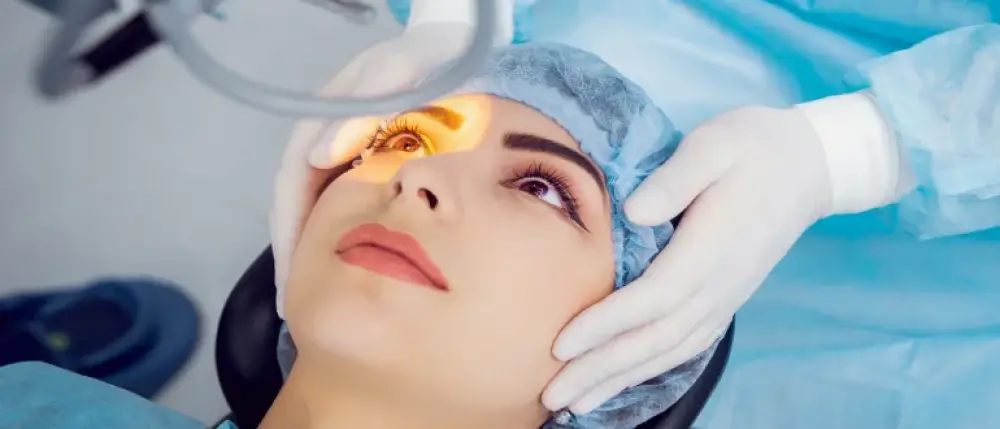
Savera Hospital
Amritsar Road, Opp. Dera Beas Moga
Phone Number
+(91) 9855827744
Send Your Mail
santnetralaya@gmail.com
Cataract
Q.What is cataract ?
A cataract is a condition that occurs inside the eye, affecting the lens responsible for focusing our vision. With the natural aging process, the lens can gradually develop cloudiness, leading to a visual impairment known as a cataract. As the cloudiness progresses, it can reach a point where it significantly reduces the clarity of vision. Essentially, a visually significant cataract is the result of the lens becoming sufficiently cloudy, impacting one’s ability to see clearly.
Q.Who gets cataract ?
Cataracts typically affect individuals over 60 due to the aging process. However, diabetes, eye injuries, and certain medications, particularly steroids, can lead to their development before reaching this age. Despite variations in onset factors, aging remains the primary cause of cataracts.
Q.What are the symptoms of cataract ?
Individuals with cataracts frequently experience a decline in their vision, manifesting as challenges in activities like reading or driving. Glare becomes a common issue, particularly in situations with bright lights, such as facing oncoming car headlights. This heightened sensitivity to glare can significantly impede visibility.
What is the Patient Evaluation Process for Cataract?
During a cataract evaluation, patients undergo a comprehensive eye exam that includes several tests. The tests commonly performed during a cataract evaluation are:
> VISUAL ACUITY TEST: This test measures the sharpness and clarity of a patient’s vision at different distances.
> SLIT-LAMP EXAM: This process uses a special microscope with an intense line of light to light up the front parts of the eye. It looks at the cornea, iris, lens, and other areas at the front of the eye.
> RETINAL EXAM: It is a test performed to examine the retina and optic nerve to detect any abnormalities. Eye drops are used to dilate the pupils to get a clear view of the retina.
> PUPIL DILATION: For this type of examination, the doctor widens the pupils to examine the lens and the back of the eye more thoroughly. It is a common test used in diagnosing cataracts. Other tests that may be performed during a cataract evaluation include eye pressure measurement by tonometry, and eye measurements (A scan) for cataract surgery. If retina is not visible then b scan ultrasonography is done. It is important to note that the tests performed during a cataract evaluation may vary depending on the doctor and the patient’s individual needs.
Q.How is cataract treated ?
There is a common misconception that cataracts can be eliminated using a laser, but this is not true. Laser treatment is not effective for cataracts, and there is no medication available for their treatment. The primary and successful method for addressing cataracts is through microscopic surgery.
During this surgical procedure, a small incision is made in the eye to remove the cloudy lens. Subsequently, a clear acrylic/plastic lens is inserted to replace the removed cloudy lens. This cataract microsurgery proves to be a highly effective approach, leading to significant improvement in vision for most individuals following the procedure.
Q.What are the different types of surgical techniques ?
1.Phacoemulsification/Micro-incision cataract surgery Phacoemulsification is a surgical procedure that uses an ultrasound probe to break up the cloudy lens for removal. First, the surgeon inserts a microscopic probe into the lens where the cataract has formed, through a tiny incision into
the cornea. This probe transmits ultrasound waves to break up or emulsify the cataract so the surgeon can remove it in miniscule pieces. The lens capsule, found at the back of your lens, is left intact so that it will hold the new artificial lens in place. Typically, the incision of this size is self-sealing, so it does not require sutures.
Here are the key features:
1. Tiny Incision: The surgery involves a very small, clear corneal incision ranging from 2.0 mm to 2.8 mm, minimizing disruption to the eye.
2. Phacoemulsification Technique: The cataract is broken into small pieces using phacoemulsification, and a flexible intraocular lens (IOL) is inserted.
3. Daycare Procedure: Patients can walk in and out on the same day, as all cataract surgeries are now performed as daycare procedures.
4. Stitchless, Bloodless, Painless: The surgery is stitchless, bloodless, and generally painless, contributing to a more comfortable experience.
5. Quick Healing: The post-operative recovery is swift, allowing patients to resume their normal activities sooner.
Small incision cataract surgery
For more advanced cataracts where phacoemulsification is not suitable, Small incision cataract surgery may be chosen. This technique requires a larger scleral incision but is still stitchless. The entire cataract is removed, and an IOL is implanted.
What is an Artificial Intraocular Lens?
After removing the cataract, it will be replaced by an artificial one called an intraocular lens (IOL). An IOL is a precisely engineered lens that is usually made of high-quality acrylic or clear plastic. It focuses the light onto the retina to improve your vision. It also comes with a special coating to protect your eyes from harmful UV rays. Like prescription eyeglasses or contact lenses, IOLs come in different focusing powers. To set this, your ophthalmologist needs to measure the length of your eye and the curve of your cornea. Unlike a contact lens, an IOL is fixed permanently inside the eye with no need for any maintenance. Once it is in place, you will not feel or see the lens at all.
Types of Intraocular Lenses:
Although all intraocular lenses are used to restore clarity of vision, there are many types of intraocular lens choices available today, with specific functions.Replacing a cloudy lens and wearing glasses may be enough for some people. Others prefer to get the best possible vision without any glasses. Ophthalmic surgeons will help you choose the right lens for you according to your budget, goal and lifestyle.
How do you Prepare for Cataract Surgery?
Immediately after surgery, your vision may be blurry, so it’s essential to arrange for someone to take you home or help you move around. To ensure your safety, your doctor will also ask about any medications or natural health products you are taking, as there are some that you may need
to stop temporarily on or before the day of surgery. Some of these medications and supplements may increase the risk of complications during your surgery. Your doctor will outline what to avoid or provide alternatives. As such, see to it that you follow these specific instructions. You may also be asked to hold off on any oral intake for up to 6 hours before the surgery. Failure to follow these dietary restrictions may cause the cancellation of your procedure.
Q. What should I expect after cataract surgery?
Within a few hours of the surgery, you will likely notice that colors are brighter, due to the removal of the clouded lens. However, your vision may be blurry during the first couple of days, and your eye may be slightly light-sensitive. Dryness, occasional itching, burning and/or red eyes are also common Most of these effects will end within a few days. Your ophthalmologist will prescribe eye drops or medications to prevent or control inflammation, infection or high pressure of the eye. An eye shield is
also recommended at bedtime to protect the operated eye. You will also be scheduled for three or four follow-up appointments with your ophthalmologist to monitor your recovery progress. A month after the surgery, you will need an eye exam so you can be prescribed new eyeglasses.
How long does it take to recover from cataract surgery?
Most patients usually go back to work with light duty two or three days after surgery. However, full recovery from cataract surgery usually takes one to two months. This includes the time needed for the eye to adjust to the replacement lens and the restoration of your vision to its highest potential.
Are there potential cataract surgery complications?
Severe intraoperative and postoperative complications are possible but notlikely and are usually manageable. Cataract surgery can restore your vision to its point prior to cataracts. However, a common development (in three out of 10 patients) following cataract surgery is an after-cataract. An after-cataract happens when part of the natural lens that is purposely not taken out during
cataract surgery develops scar tissue and blurs your vision. Unlike a cataract, an after-cataract can be treated with a method called YAG laser capsulotomy. The surgeon uses a laser beam to make a tiny hole in the scar tissue behind the lens to let the light pass through. After-cataracts may
develop weeks, months — or even years — after cataract surgery. Complications are more likely if you have another eye condition. Sometimes it’s better to treat other conditions prior to having cataract surgery to ensure that you obtain the best visual results.
Other Services

Comprehensive Exams

Dry Eyes Services

Advanced Ocular Care
Why Patients Choose Savera Eye Hospital
Patients choose Savera Eye Hospital for a variety of reasons, each reflecting our commitment to excellence in eye care and patient satisfaction. Here are some of the key factors that set us apart and make us the preferred choice for individuals seeking trusted eye care services.
01
Medical Experience
Savera Eye Hospital boasts a team of highly skilled and experienced ophthalmologists, optometrists, and support staff dedicated to delivering exceptional eye care. Our specialists have undergone rigorous training and possess extensive expertise in their respective fields, ensuring that our patients receive the highest standard of care.
02
Art Technology
We invest in cutting-edge technology and advanced equipment to provide precise diagnoses and effective treatments for a wide range of eye conditions. From diagnostic imaging tools to surgical instruments, our state-of-the-art facility is equipped with the latest advancements in eye care technology.
03
Comprehensive Services
Savera Eye Hospital offers a comprehensive range of eye care services, including routine eye exams, cataract surgery, refractive surgery, glaucoma management, retinal services, pediatric eye care, and more. Whether you need preventive care or specialized treatment, we have the expertise and resources to meet your needs.
04
03
Personalized Care
We understand that each patient is unique, and we take a personalized approach to care. From the moment you walk through our doors, our dedicated team takes the time to listen to your concerns, answer your questions, and develop a customized treatment plan tailored to your specific needs and goals.
04
04
Commitment to Quality and Safety
We adhere to the highest standards of quality and safety in everything we do. From maintaining strict infection control protocols to following evidence-based practices, we prioritize patient safety at every step of the way. Our commitment to quality is reflected in our consistently excellent outcomes and high patient satisfaction rates.

Savera Hospital was established in 2010 by Dr. Rajiv Kumar Gupta with the aim to provide high-quality, accessible and affordable eye care for all.
Make Appointment
- Monday - Saturday 09 AM - 04 PM
- SUNDAY 10 AM - 01 PM
Powered by Savera Eye Hospital- Moga (Punjab)
Copyright © 2024. All rights reserved.
